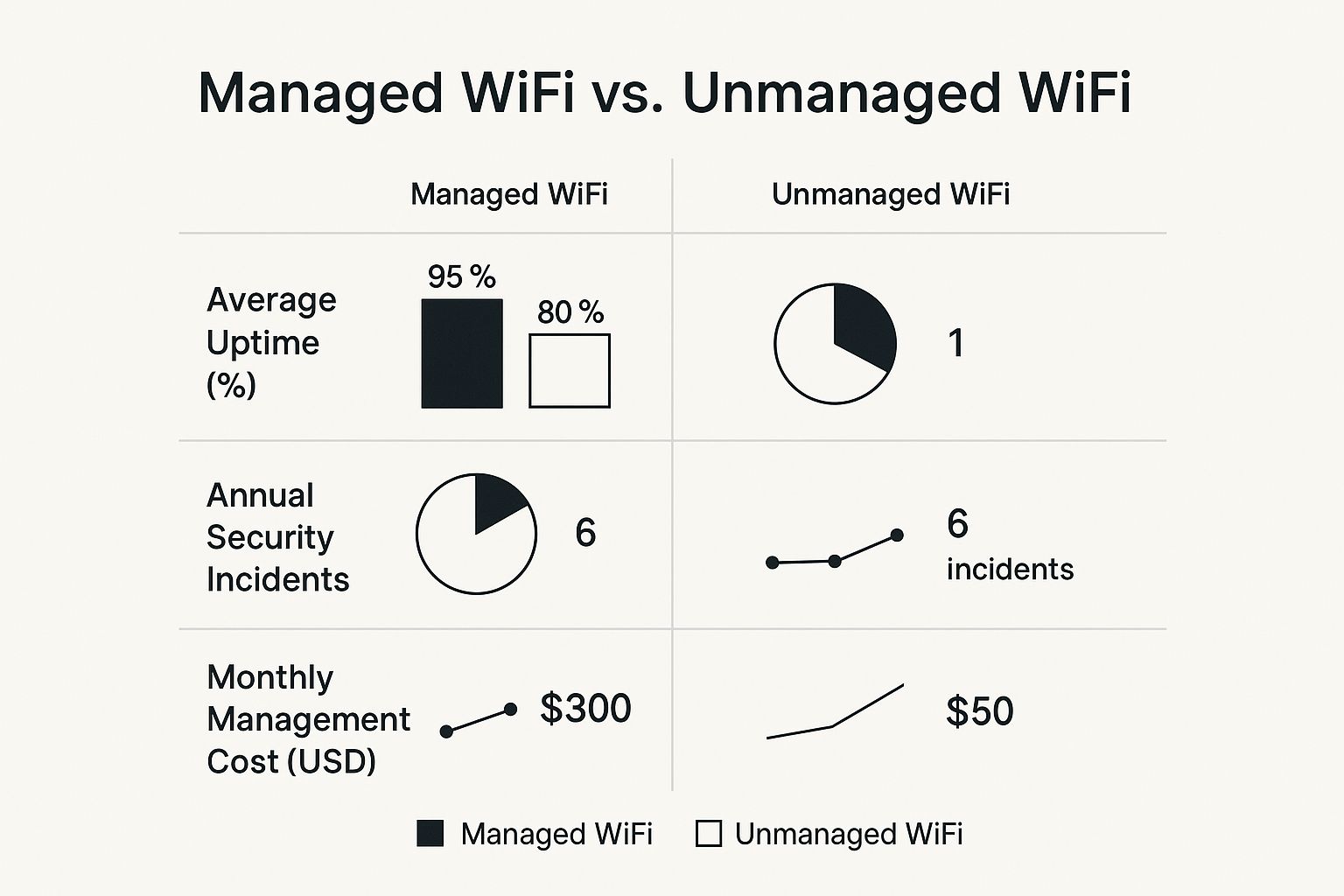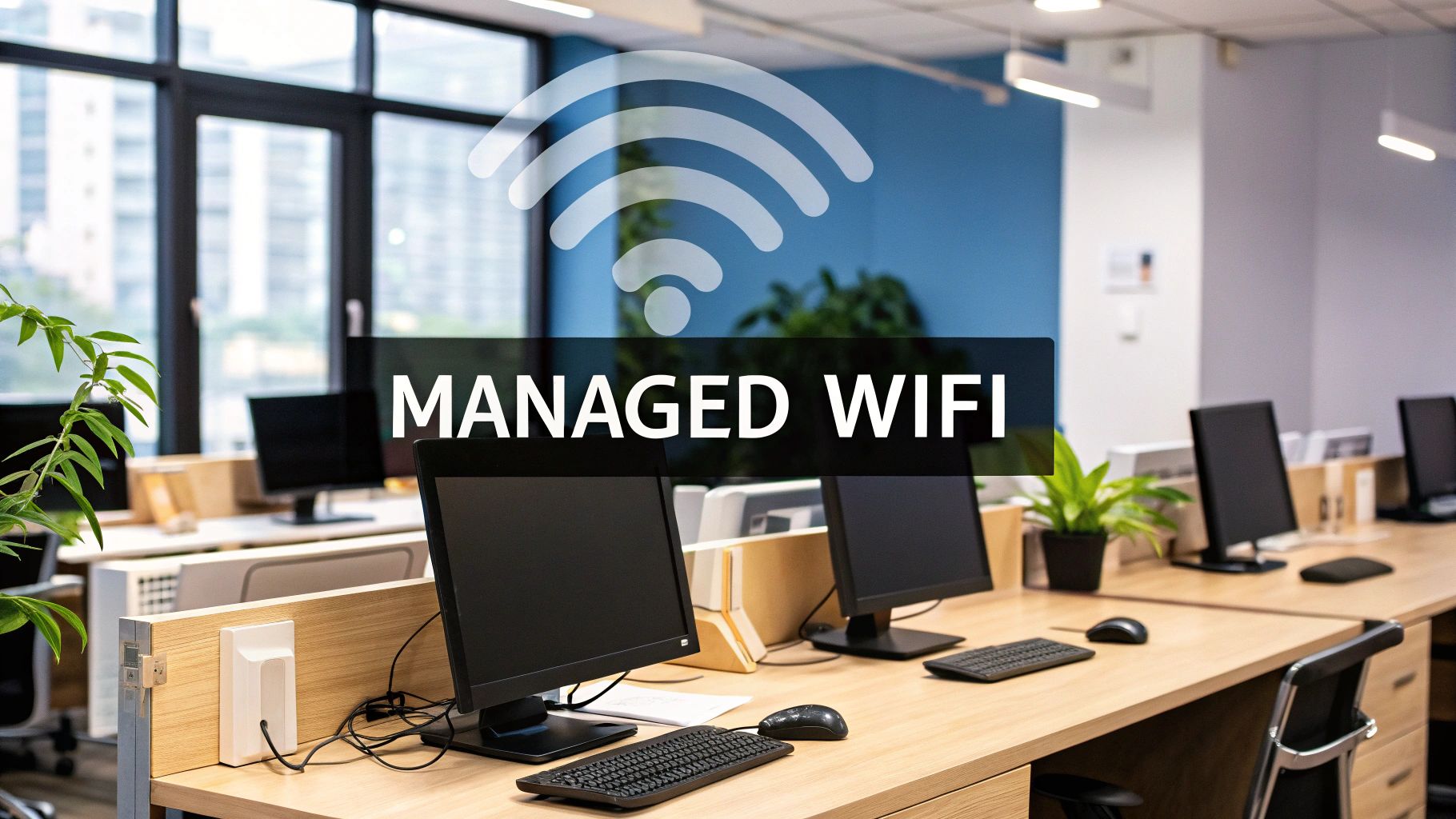Think of a managed Wi-Fi network as a fully outsourced, professional service for your entire wireless system. Instead of your team wrestling with routers and troubleshooting dead spots, a dedicated third-party provider designs, installs, monitors, and maintains everything for you. This approach gives your business top-tier performance and security without the headache of managing it all in-house.
So, What Is a Managed Wi-Fi Network, Really?
Let’s use an analogy. Imagine your business Wi-Fi is a high-performance car. You could buy the car, try to learn the mechanics, handle every oil change, and frantically fix it when it breaks down on the side of the road. Or, you could have a professional pit crew on standby, keeping it perfectly tuned, secure, and running at peak performance 24/7. That pit crew is your managed Wi-Fi provider.
This is far more than just getting an internet connection. It’s a complete service where experts handle everything from the initial network design and hardware setup to constant security monitoring and performance tweaks. It’s a true end-to-end solution built to deliver flawless connectivity.
A managed Wi-Fi network shifts the entire burden of uptime, security, and performance from your team to a specialized provider. This turns your Wi-Fi from a potential headache into a reliable, strategic asset that actually helps your business grow.
Moving From DIY to a Professional Service
We live in an era of connected everything—employee laptops, point-of-sale systems, guest smartphones, and even IoT sensors. A simple, off-the-shelf router just can’t keep up anymore. The “as-a-service” model is no longer an IT luxury; it’s becoming a core necessity for any business that depends on seamless and reliable internet.
This shift is clear in the market trends. The managed Wi-Fi solutions market, currently valued at USD 6.52 billion, is expected to skyrocket to USD 13.26 billion by 2029. This growth sends a strong message: businesses are choosing to outsource their network management to get better performance and much stronger security.
This visual breaks down some key differences between managed and unmanaged Wi-Fi, highlighting crucial metrics like uptime, security, and overall cost.

As you can see, while there’s a predictable management fee, a managed service delivers dramatically higher uptime and far fewer security breaches, which ultimately protects your operations and your reputation.
Managed WiFi vs. DIY WiFi at a Glance
For many businesses, the choice comes down to handling Wi-Fi in-house or bringing in the experts. This table breaks down the core differences in a side-by-side comparison.
| Feature | DIY WiFi (Unmanaged) | Managed WiFi Network |
|---|---|---|
| Setup & Installation | You buy hardware and figure out placement and setup. | Experts design and install a custom network for your space. |
| Monitoring | Reactive; you only know there’s a problem when it fails. | Proactive 24/7 monitoring to catch issues before they happen. |
| Security | Basic, relies on default settings and manual updates. | Enterprise-grade security with regular patching and threat defense. |
| Support | You or your staff are the support team. | Access to a dedicated team of certified network engineers. |
| Cost Structure | Upfront capital expense for hardware, plus surprise costs. | Predictable monthly operational expense, no surprise fees. |
| Performance | Often inconsistent, with dead zones and slowdowns. | Optimized for peak performance and reliable coverage. |
The takeaway here is pretty clear. A DIY approach might seem cheaper upfront, but a managed service provides a level of reliability, security, and peace of mind that an unmanaged network simply can’t match.
The Real Value Proposition
So, why make the switch? The main reasons businesses embrace a managed Wi-Fi network come down to a handful of powerful benefits:
- Expertise on Demand: You get immediate access to a team of certified network engineers without the massive overhead of hiring them full-time.
- Proactive Problem Solving: Thanks to round-the-clock monitoring, issues are often identified and fixed before your users or operations are ever affected.
- Enhanced Security: Your provider implements powerful security protocols, handles all the updates, and actively monitors for threats to keep your business safe.
- Predictable Costs: You pay a simple, fixed monthly fee. This makes budgeting a breeze and eliminates those nasty, unexpected bills for hardware repairs or replacements.
At the end of the day, this approach lets you offer world-class Wi-Fi without dealing with the world-class headaches that come with it.
Looking Under the Hood of a Managed Service

When you sign up for a managed Wi-Fi network, you’re getting so much more than an internet connection. You’re bringing in a complete system built from the ground up for rock-solid reliability and peak performance. So, let’s pop the hood and see what makes this kind of service really tick.
A managed Wi-Fi service stands on three core pillars: enterprise-grade hardware, intelligent software, and dedicated human expertise. Each piece is designed to work in perfect sync, delivering a seamless experience that a typical off-the-shelf, DIY setup just can’t match. This tight integration is what separates a professional solution from the rest.
The Hardware Powering Your Connection
While the hardware might be the most visible part of your Wi-Fi network, it’s a world away from the router you’d buy at a big-box store. Providers use enterprise-grade equipment that’s purpose-built for the tough demands of a commercial space.
Think of it like the difference between a family car and a commercial delivery truck. Both can get you from point A to B, but only one is engineered for relentless, day-in, day-out performance under heavy loads.
This gear includes a few key components:
- Access Points (APs): These aren’t just signal repeaters. Professional APs are workhorses, built to handle dozens or even hundreds of devices connecting at the same time without breaking a sweat. They’re placed strategically based on a detailed site survey to kill dead zones and blanket your entire space with strong, consistent coverage.
- Network Switches: Picture these as the air traffic controllers for your network’s data. They direct the flow of information between all your devices, and managed switches come with powerful features like Quality of Service (QoS). This allows them to prioritize essential traffic—like a smooth video conference call over a large file download—to keep things running perfectly.
- Security Gateways: This is your network’s digital bouncer. It provides a robust firewall, intrusion detection, and content filtering that go far beyond what a simple password can offer, keeping your data and your users safe.
Intelligent Software and Centralized Control
The hardware is the muscle, but the “brains” of a managed Wi-Fi network live in its sophisticated software. This is typically run from a centralized cloud dashboard, giving both you and your provider a single, real-time command center to view the network’s health.
This software layer is what makes proactive management possible. Instead of waiting for someone to complain about slow Wi-Fi, the system can automatically flag a failing access point or a weird traffic spike and alert technicians right away.
Modern managed services rely heavily on robust cloud infrastructure. This not only allows for centralized management and monitoring but also provides advanced analytics, which is especially vital when managing countless connected IoT devices. To get a better sense of how the cloud enables these scalable systems, it helps to understand its role in cloud computing in IoT environments. This backend intelligence is the key to spotting trends, fine-tuning performance, and growing the network right alongside your business.
The Essential Human Element
Finally, and maybe most importantly, you have the team of experts behind the curtain. A managed solution is backed by certified engineers and support staff who oversee your network’s entire lifecycle. It’s this human touch that truly sets the service apart.
Their responsibilities cover everything from start to finish:
- Initial Design and Installation: A professional conducts an in-depth site survey to map out the perfect network layout, leaving no corner without coverage.
- 24/7 Monitoring and Support: A dedicated team keeps a constant watch on your network. If a problem crops up at 2 AM on a Saturday, they’re likely already working on a fix before you or your users even notice.
- Security Management: The team handles all security updates, firmware patches, and ongoing threat monitoring. As new cyber threats emerge, your defenses are kept sharp without you ever having to lift a finger.
This continuous human oversight ensures the technology isn’t just set up and forgotten. It’s actively managed and optimized to help you meet your specific business goals, turning your Wi-Fi from a basic utility into a powerful, resilient asset.
The Real-World Benefits for Your Business

Let’s get past the technical jargon. The real magic of managed Wi-Fi isn’t just about faster downloads; it’s about what that power does for your business. We’re talking about a genuine competitive edge built on rock-solid security, an amazing user experience, and much smarter financial planning.
Ultimately, this service transforms Wi-Fi from a constant headache and cost center into a strategic tool that actually helps you grow. Let’s dig into the tangible advantages you can expect.
Fortified Security and Peace of Mind
In today’s world, a single security slip-up can be disastrous. A managed Wi-Fi network acts as a powerful shield against cyber threats, bringing in security measures that are worlds beyond what you get out of the box with standard equipment. Think of it as upgrading from a simple deadbolt to a full-blown security system, complete with 24/7 guards.
Your provider takes on all the critical, time-sucking security work. This means deploying firewalls, constantly applying security patches to fend off the latest threats, and actively monitoring network traffic for anything suspicious. This proactive approach is your best defense against data breaches and helps ensure you meet compliance standards like PCI DSS or HIPAA.
By handing over security to the experts, you’re not just buying equipment—you’re buying peace of mind. You can finally focus on running your business, knowing your network is protected by pros.
Delivering an Exceptional User Experience
We’ve all been there: slow, spotty Wi-Fi is infuriating. For a customer in your cafe or a guest in your hotel, a bad connection can sour their entire visit. For an employee, it’s a productivity killer. A properly managed network is designed from the ground up to make these problems disappear.
Providers use enterprise-grade access points and perform detailed site surveys to guarantee strong, seamless coverage everywhere—no more dead zones. They also fine-tune the network to handle crowds, so performance stays snappy even when dozens or hundreds of people connect at once.
What does this look like in reality?
- Happier Customers: People who get fast, easy-to-use Wi-Fi are far more likely to come back and leave glowing reviews.
- More Productive Employees: Your team can work without a hitch, whether they’re on a video call, using cloud software, or processing payments.
This consistent, reliable performance becomes a key feature that sets you apart from competitors who are still wrestling with their DIY network setups.
Seamless Scalability and Future-Proofing
Your business is always evolving, and your network needs to keep up. One of the biggest perks of a managed service is its built-in flexibility. Need to cover a new building expansion, handle a seasonal rush of customers, or support a new fleet of IoT devices? Your provider has it covered.
Scaling your network is as simple as making a request. They’ll deploy and configure the new hardware, so you don’t have to get bogged down in the technical details. This agility means your network grows right alongside your business, effortlessly.
This is a major reason the global market for these solutions is booming. Businesses are realizing it’s more efficient to let experts manage the entire wireless lifecycle, from installation to upgrades, while they focus on what they do best.
Predictable Costs and Smarter Budgeting
Finally, a managed Wi-Fi network takes the guesswork out of your IT budget. The old way of doing things—buying hardware upfront—means a huge initial cost, followed by unexpected expenses for repairs, replacements, and emergency calls. It makes financial planning a nightmare.
With a managed service, you shift to a predictable monthly subscription. This operational expense (OpEx) model wraps everything into one flat fee: the hardware, installation, monitoring, support, and even future equipment upgrades. No more surprise bills when an access point dies. Our guide on the advantages of a managed Wi-Fi service explains how this model streamlines your finances.
This approach makes your budget far more reliable and protects you from those costly, out-of-the-blue IT emergencies.
How Different Industries Win with Managed WiFi

A top-tier managed WiFi network isn’t a one-size-fits-all solution. Its real power is unlocked when it’s carefully molded to the unique pulse of an industry. After all, what works for a chaotic hotel lobby is completely different from what a high-density apartment complex or a sprawling corporate campus needs.
The true beauty of a managed service is its chameleon-like ability to adapt. By digging into the specific operational goals of each sector, a provider can engineer a network that doesn’t just provide internet—it solves real-world problems, opens up new opportunities, and actively drives success.
Let’s look at how this plays out on the ground.
Hospitality: Perfecting the Guest Experience
In the world of hospitality, the guest experience is king. A spotty or confusing Wi-Fi connection has gone from being a small hiccup to a primary driver of bad reviews and lost business. A well-designed managed WiFi network tackles this head-on, creating a smooth, secure, and branded experience from the second a guest steps through the door.
Think about it. A guest arrives and their device just… connects. The network is fast, it’s secure, and it even recognizes them. This is where managed services shine, allowing for features crucial to hotels:
- Tiered Bandwidth Options: You can offer a solid, free connection for casual browsing while providing a premium, high-speed tier for a fee. This not only satisfies power users who need to stream movies or join video calls but also creates a brand-new revenue stream.
- Property Management System (PMS) Integration: The network can talk directly to your PMS. This means you can automate Wi-Fi access, greet guests by name on a personalized login page, and even push special offers for the hotel spa or restaurant right to their device.
- Seamless Roaming: A professionally designed grid of access points ensures guests can walk from their room to the pool and then to the bar without their connection ever dropping.
A thoughtfully implemented managed WiFi network stops being a simple utility and becomes a cornerstone of the entire guest experience. It’s that invisible touch that makes a stay memorable and turns happy guests into glowing online reviews.
Residential Living: Attracting and Retaining Tenants
For multi-family apartment buildings, student housing, and senior living communities, high-speed internet is no longer just another utility line item. It’s a make-or-break amenity that directly impacts occupancy rates. Offering building-wide, professionally managed WiFi is a powerful way to stand out from the competition and keep tenants happy for the long haul.
Instead of forcing every resident to navigate the confusing world of individual internet providers, a managed solution delivers a single, powerful network for the whole property. Residents get hassle-free, instant-on connectivity from the moment they move in. It also means consistent, reliable performance everywhere—from individual apartments to the gym and the community lounge. This approach adds tremendous value and just makes life simpler for everyone.
The shift from networks that just had to handle a few laptops to those that support hundreds of devices across an enterprise-grade area is what makes managed solutions so necessary today. As detailed in this market analysis, providers now cover the entire lifecycle of a wireless network, from initial planning and installation to security audits and 24/7 monitoring. This is perfect for organizations that want to offload complex IT tasks and focus on their core business.
Commercial and Corporate Spaces: Boosting Productivity
In commercial settings like offices, warehouses, and retail stores, the network is under intense, multi-faceted pressure. It has to be a security fortress, a performance powerhouse, and a flexible foundation for whatever comes next. A managed WiFi network is specifically built to conquer these challenges.
Just picture a modern office. The network has to juggle hundreds of employee laptops, constant video calls in conference rooms, guest devices, and a growing army of IoT sensors managing everything from lighting to climate control. A standard, off-the-shelf setup would quickly crumble, leading to frustrated employees and lagging applications. A managed service, on the other hand, is designed from the ground up for this kind of high-density pressure.
While the end goal is always reliable connectivity, the specific priorities can vary dramatically from one industry to the next.
Sector-Specific Managed WiFi Priorities
This table summarizes the unique requirements and primary benefits of managed WiFi across key business sectors.
| Sector | Primary Goal | Key Features to Prioritize |
|---|---|---|
| Hospitality | Unforgettable Guest Experience | PMS Integration, Tiered Access, Branded Portals |
| Residential | Attract & Retain Tenants | Building-Wide Coverage, Instant-On Access, Reliable Streaming |
| Commercial | Boost Productivity & Security | High-Density Support, Robust Security, IoT Enablement |
As you can see, the “why” behind the network shapes the “how.”
For corporate spaces, security is often the number one concern. A managed provider will create completely separate, isolated networks for corporate, guest, and IoT traffic. This ensures that a visitor checking their email has absolutely no pathway to sensitive company files. This network segmentation, combined with continuous threat monitoring, is what keeps your digital assets safe and your team productive.
Calculating the True ROI of Your Network
It’s easy to get caught up in features and tech specs, but the conversation eventually has to turn to finance. To really see the value in a professional solution, you need to calculate the true return on investment (ROI). This isn’t just about stacking a monthly service fee against the cost of buying a few routers from a big-box store.
The reality is, a DIY network is full of hidden costs that slowly but surely drain your resources. To get an honest look, you have to account for lost productivity when the internet inevitably goes down, the hours your staff (or you!) waste trying to fix connection problems, and the huge financial hit a security breach could cause. A managed Wi-Fi network flips this entire financial picture on its head.
Beyond the Monthly Fee: The Hidden Costs of DIY
The upfront cost of a few routers is just the tip of the iceberg. The real expense of an unmanaged network shows up in the little disruptions and daily headaches. It’s the time your team can’t get into critical cloud apps or the sales you miss when your payment system suddenly goes offline.
Think about these “soft costs” that add up faster than you’d think:
- Lost Productivity: When the Wi-Fi is down, work stops. Even just a sluggish connection can translate into hours of wasted payroll every single month across your entire team.
- IT Staff Overload: Every hour your IT expert spends wrestling with a Wi-Fi glitch is an hour they can’t spend on projects that actually move the business forward. In smaller companies without an IT department, this headache lands squarely on the owner’s shoulders.
- Customer Dissatisfaction: If you’re in hospitality or retail, bad Wi-Fi can directly lead to bad reviews and customers who never come back. People just expect good connectivity now; it’s part of the deal.
From Cost Center to Strategic Asset
This is where a managed Wi-Fi network really changes the game. It turns your internet from a frustrating, unpredictable expense into a reliable asset. That predictable monthly fee isn’t just for hardware—it’s buying you uptime, security, and peace of mind. And all of those things have a real, tangible dollar value.
The true ROI of a managed network is found by subtracting the “hidden costs” of your old DIY system from the new operational efficiencies. It’s not just about what you spend, but about what you stop losing.
Imagine a simple before-and-after. Your team used to lose maybe five hours a month to connection drops, and a manager spent another three trying to get things working again. A managed service wipes that waste off the books, instantly putting eight hours of paid time back into productive work.
Calculating Your Potential Return
To make a solid business case, you have to start putting numbers to the problems with your current setup. This simple framework can help you see the financial impact pretty clearly.
| Cost Category | DIY Network (Monthly Estimate) | Managed Network (Monthly) |
|---|---|---|
| Hardware & Repairs | $50 (Spread out + unexpected fixes) | $0 (Included in fee) |
| Lost Productivity | $200 (Based on downtime) | $0 |
| IT Troubleshooting | $150 (Staff time) | $0 |
| Security Risk | High (Hard to quantify, but huge) | Low (Handled by experts) |
| Service Fee | $0 | $250 (Example fee) |
| Total Monthly Cost | $400 + High Risk | $250 + Low Risk |
Even in this simplified example, it’s clear how a managed solution becomes the more cost-effective choice once you look at the whole picture. It also tightens up your security, a benefit that’s tough to put a price on but is absolutely priceless. A key part of that security is creating different access levels, like a separate network just for visitors. To learn more, check out our guide on how to set up guest Wi-Fi and protect your main network.
Got Questions About Managed WiFi? We’ve Got Answers.
Making the leap to a managed WiFi network is a big decision. You’re essentially handing over a critical piece of your business infrastructure to a team of outside experts, so it’s only natural to have a few questions. You need to feel confident and clear on what you’re getting into.
Let’s walk through some of the most common things business owners ask. We’ll give you straight, no-fluff answers to help you see exactly how a managed solution could fit into your bigger picture.
Will I Lose Control Over My Network?
This is easily the biggest worry we hear, and the answer is a firm no. You don’t lose control; you just offload the technical headaches. Think of it like hiring a professional pilot for your private jet. You still decide the destination, but you let the expert handle the complex flight controls, navigation, and engine monitoring.
A good managed service provider gives you a user-friendly dashboard—a single screen where you can see everything that matters. From there, you can:
- See network health at a glance: Check uptime, speeds, and how the hardware is performing in real-time.
- Understand user activity: Get insights into how many people are connected, peak usage times, and what they’re doing online.
- Make quick, simple tweaks: While the provider handles the heavy lifting, you can still do things like update the guest password or see who’s connected.
You get total transparency and all the important insights, while the provider deals with the nitty-gritty stuff like firmware updates, security patches, and hardware maintenance. It’s the best of both worlds: full visibility, zero hassle.
Is This Only for Large Corporations?
Not at all. While massive companies definitely see the benefits, a managed WiFi network is often a game-changer for small and medium-sized businesses (SMBs). Most SMBs don’t have a dedicated, in-house IT department, which means network management falls on the owner or an employee who already has a full-time job.
A managed service levels the playing field. It gives SMBs access to the same enterprise-grade hardware, advanced security, and 24/7 expert support that the big corporations rely on—all for a predictable monthly cost that would be impossible to match in-house.
Instead of stretching your team thin or, worse, ignoring critical security updates, you can hand off the entire responsibility. This frees up so much time and mental energy to focus on what actually drives your business, like taking care of customers and finding new ways to grow.
What Happens if My Business Needs to Scale?
This is where the managed service model really shines. Scaling your network up or down is surprisingly simple and flexible, which is a world away from the pain of doing it yourself with equipment you own.
Let’s say you run a boutique hotel and you’re planning to add a new wing, or a retail shop getting ready to open a second location. With a traditional setup, you’d be looking at a huge upfront cost for new hardware, not to mention the nightmare of trying to get it all to work with your old system.
With managed WiFi, the process is clean and simple:
- You let your provider know about your expansion plans.
- They handle the design, mapping out the new coverage area and sourcing all the right gear.
- Their technicians come in to install and configure everything, making sure the new access points blend seamlessly with your existing network.
This agility works both ways. If you need to downsize or close a location, your plan can be adjusted. You’re never stuck with a closet full of expensive, oversized hardware you don’t need. Your IT infrastructure becomes as nimble as your business.
How Is This Different from My ISP’s WiFi?
This question really gets to the core of it. The little router your Internet Service Provider (ISP) gives you is built for basic, residential use—a small home or a tiny office with maybe a few phones and laptops. A managed WiFi network, on the other hand, is a complete, commercial-grade system engineered for the demands of a real business environment.
Here’s a quick breakdown of what separates them:
| Feature | ISP Router (Basic WiFi) | Managed WiFi Network (Commercial Solution) |
|---|---|---|
| Coverage | A single box with a limited signal, creating frustrating dead zones. | Multiple, strategically placed access points for rock-solid, wall-to-wall coverage. |
| Security | A simple password and a very basic firewall. | Enterprise-grade security with threat monitoring, content filtering, and network segmentation. |
| Capacity | Buckles under the pressure of more than a handful of users. | Built to handle high-density spaces with hundreds of simultaneous connections. |
| Support | A generic 1-800 number with long waits for someone who might be able to help. | Proactive 24/7 monitoring and a dedicated team of certified network engineers. |
To put it simply, an ISP sells you an internet connection. A managed WiFi provider delivers a robust, reliable, and secure wireless ecosystem designed from the ground up to support and grow your business.
Ready to stop worrying about your WiFi and start focusing on your business? Clouddle Inc delivers enterprise-grade managed network solutions with zero down payment and 24/7 expert support. Discover how our tailored services can boost your security and performance by visiting us at https://www.clouddle.com.


